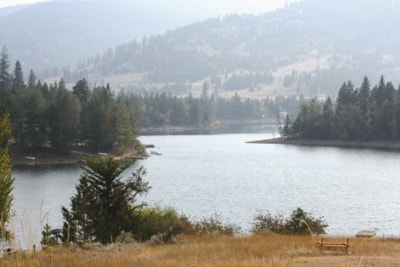A development permit application from Twin Lakes Golf Course was the main topic of discussion at the September 20 meeting of the regional district board.
After a presentation by members of the Lower Nipit Improvement District, headed by Coral Brown, Mike Seymour of MSR Solutions, accompanied by Suki Sekhon, owner of the Twin Lakes Golf Course, addressed the board over their application for a variance permit.
The permit application sought to reduce the maximum daily flow of water needed for a community water system from the present 8,000 litres per day to 1,900 litres per day.
Sekhon plans to develop 136 single detached dwellings and 72 multi family units on a rock ledge above the golf course. The development proposal hit a road block last year when the provincial approving officer ruled that the project was “not within the public interest” due to concerns over a sustainable water supply in the Twin Lakes area.
Seymour told the board that his company had retained consultants Golder Associates to gather further data regarding the capacity of the Twin Lakes aquifer. He was expecting a draft report after this irrigation season, and felt the report would contain sufficient data to make a decision on the aquifer’s capacity at that time.
Seymour presented the argument that the regional district’s present daily demand requirements were not realisitc, suggesting that if more realistic daily demand rates were adopted, the development, adhering to strict water conservation principles, would be viable.
Sekhon told the board that the golf course had cut water use by 35 per cent in the past four years.
“We want restrictions,” he told the board, “we are not here today for development approval.”
The golf course’s water “best practices” were challenged by Osoyoos Director Stu Wells, who noted that historical use of water had been “unwise.”
Sekhon told the board that in his first year of operation the course had been overwatered, but that had since been corrected. H e said that Golder and Associates was currently conducting a “six figure study” and that his company was engaged in a “long and costly process” to gather scientific data on the aquifer’s capacity.
Some dispute occurred over the actual number of years consistent data logging had been taking place. Area “G” Director Angelique Wood questioned Seyour several times over the number of years regular, consistent measurements had taken place in the aquifer. Her questioning at one point revealed that some data had been sourced from records based in the Okanagan valley.
“Our hydrogeologist is paid very well to extrapolate this data,” Seymour insisted.
Directors also saw potential problems looming over the future takeover by the regional district of the development’s water and sewage systems, should water be in insufficient supply, noting an added risk was possible. When asked how he anticipated that handover going, Sekhon replied, “There’s a (consumption) number we should all be living with - everyone should abide by it.”
Area “D” Director Tom Siddon saw the motion as “putting the cart before the horse” as the regional district did not yet have sufficient information to deal with the matter. He expressed the need to continue moving toward a solution, adding that Sekhon had a right to push the matter forward. The solution would not be simple, however.
West Bench Director Michael Brydon agreed that Sekhon’s request was legitimate, noting that there was “a lot of good (discussion) going on here.”
“Twin Lakes aquifer is the canary in the coal mine,” he said, “we have to move extremely carefully on this.”
Oliver Director Ron Hovane and Oliver rural Director Allan Patton both noted that the regional district was promoting the Twin Lakes area as a secondary growth location in its regional growth strategy.
“We don’t want the responsibility for the water systems in this community,” Hovanes said.
“Why would we tax an already overtaxed aquifer?” Patton questioned. “Three seasons of data collection is not relevant. This area should not be in the secondary growth category.
We shouldn’t be encouraging the developer fo spend any more money.”
The motion before the board - to deny a variance to the subdivision servicing bylaw to reduce the maximum daily flow of water needed for a community water system from 8,000 litres per day to 1,900 litres per day - was deferred until the release of Golder’s report, expected later this year.
